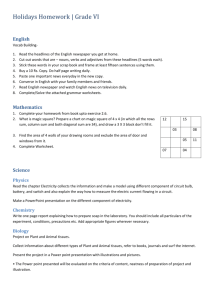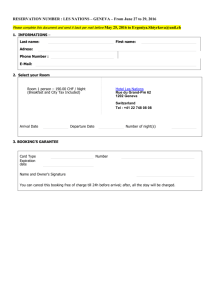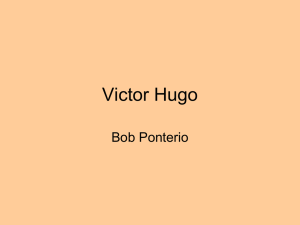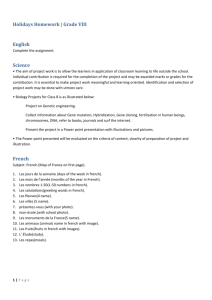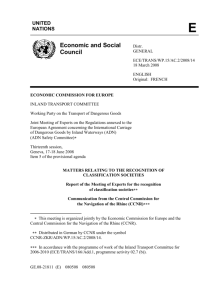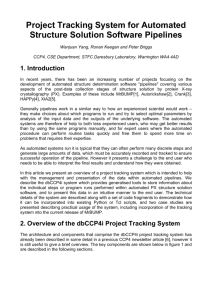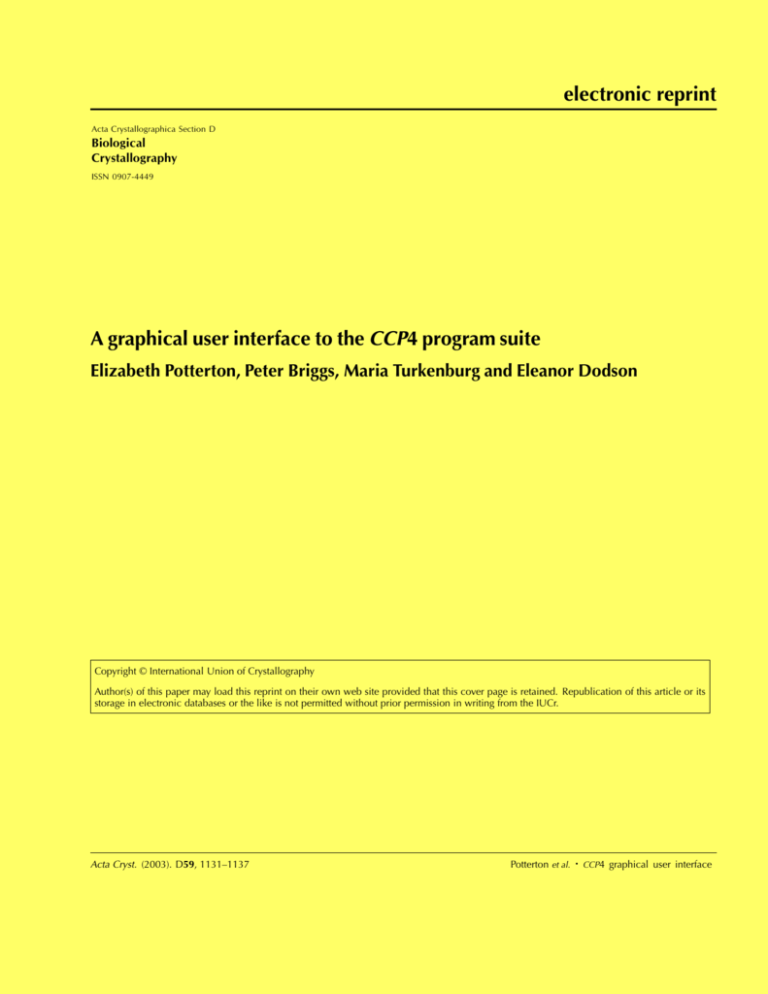
electronic reprint
Acta Crystallographica Section D
Biological
Crystallography
ISSN 0907-4449
A graphical user interface to the CCP4 program suite
Elizabeth Potterton, Peter Briggs, Maria Turkenburg and Eleanor Dodson
Copyright © International Union of Crystallography
Author(s) of this paper may load this reprint on their own web site provided that this cover page is retained. Republication of this article or its
storage in electronic databases or the like is not permitted without prior permission in writing from the IUCr.
Acta Cryst. (2003). D59, 1131–1137
Potterton et al.
CCP4 graphical user interface
research papers
Acta Crystallographica Section D
Biological
Crystallography
A graphical user interface to the CCP4 program
suite
ISSN 0907-4449
Elizabeth Potterton,a* Peter
Briggs,b Maria Turkenburga and
Eleanor Dodsona
a
Department of Chemistry, University of York,
York YO10 5YW, England, and bDaresbury
Laboratory, Warrington WA4 4AD, England
CCP4i is a graphical user interface that makes running
programs from the CCP4 suite simpler and quicker. It is
particularly directed at inexperienced users and tightly linked
to introductory and scienti®c documentation. It also provides
a simple project-management system and visualization tools.
The system is readily extensible and not speci®c to CCP4
software.
Correspondence e-mail: lizp@ysbl.york.ac.uk
1. Introduction
# 2003 International Union of Crystallography
Printed in Denmark ± all rights reserved
The Collaborative Computational Project, Number 4 (CCP4)
is a collaboration in crystallographic software development
that is best known for distributing a suite of crystallographic
programs and software libraries (Collaborative Computational Project, Number 4, 1994). The software libraries support
some standard crystallographic ®le formats and provide tools
for command parsing, symmetry handling and other
commonly used functionality. The programs distributed by
CCP4 have been written in many different laboratories, but
mostly use the software libraries and follow certain conventions to ensure a consistent style of keyworded input. CCP4
permanent staff ensure that distributed programs have
consistent documentation and a common build mechanism
which works for a wide range of platforms and provide user
support.
The CCP4 suite is a collection of stand-alone programs
rather than one large program. For some operations, several
programs are run in succession, with data transfer between
programs being mediated by ®les in the standard formats
supported by the software libraries. This approach allows
¯exibility for both programmers and users, but it can be
dif®cult for inexperienced users. Most programs have a range
of functionality that is controlled by keywords in a command
script which is usually embedded in a Unix shell script. A Unix
script might run several programs in succession and in itself
encode some of the functionality. The user must have some
programming skills to create these scripts or at least to edit
parameters and ®le names in existing scripts. This process is
slow and scripts are sometimes not up to date with the current
best use of programs.
Running CCP4 programs has been much simpli®ed by a
graphical user interface called CCP4i, which provides standard scripts to run all of the common tasks and a graphical
interface to each task that enables the user to enter parameters and names of input and output ®les. Each task
interface is designed to require minimal user input to work in a
default mode, but provides access to the full range of functionality available in the programs. In addition to interfacing
to crystallographic tasks, CCP4i provides a project database
that records details of each task run and can display a wide
Acta Cryst. (2003). D59, 1131±1137
Potterton et al.
electronic reprint
Received 23 October 2002
Accepted 9 April 2003
CCP4 graphical user interface
1131
research papers
The graphical interface of CCP4i
consists of a main window, shown in Fig.
1. On the left-hand side of the main
window is a menu listing the tasks; when
a task is selected, a separate task interface window is opened. In the centre of
the main window is the `Job List', which
lists all of the jobs which have been run
for the current project. The user can
Figure 1
select a job from the list to apply a
The layout of main window of the CCP4i graphical interface. The left-hand frame of the window is
utility such as displaying input or output
the task menu, the centre frame is the Job List and the right-hand frame contains utilities.
®les from the job or rerunning the job.
Each task within the interface has a
separate interface window which presents the user with the
options for running the task, allows them to select input and
output ®les and to start a job. All task windows have a similar
layout to the interface shown in Fig. 2 for the DM densitymodi®cation program (Cowtan & Main, 1998). The task
interface is divided into horizontal folders. The top folder,
called the `protocol folder', has the most signi®cant options
that determine the action of the task. Next is the `®le folder', in
which the user can select input and output ®les and also select
the column data from an input re¯ection data ®le in MTZ
format. Each subsequent folder contains groups of related
options whose functionality is indicated by the name in the
title line of the folder. All folders except the protocol and the
®les folder may be closed so that the body of the folder is not
visible. The title line of a folder is always visible and clicking
on this line will open or close the folder. The folders are
arranged with the more signi®cant groups of options nearer
the top of the window; folders containing infrequently used
options are closed by default.
An important feature of the task interface is that as the user
Figure 2
selects
options, the interface is adjusted to display only the
An example of the layout of a task interface: the DM task interface. The
window is split vertically into frames. The top frame is the protocol frame
appropriate sub-options. In particular, the rest of the interface
for key decisions and the next frame is for ®le selection. All subsequent
may be customized depending on choices made in the protocol
frames have a title bar with the name of the frame. Frames containing less
folder.
popular options are closed by default but can be opened by clicking on
The default parameters for a task will perform the most
the title line.
popular function of the task and the user should only need to
select ®les and sometimes enter some non-defaultable data
range of ®le formats. There is extensive documentation and
such as the expected solvent content. There are two
there are tutorials that teach the use of the programs and some
mechanisms for providing additional information on each
basic crystallography.
parameter in the window: the message line at the top of a
The interface is written in the Tcl scripting language using
window gives one line of information dependent on the
the Tk graphical toolkit (Tcl Developers; http://www.tcl.tk).
current cursor position and a mouse click on any parameter
The BLT extension to Tk is used to create graphs and tables.
brings up a web browser to access documentation for that
These packages, and therefore CCP4i, will run on many
parameter. There is also introductory documentation for each
operating systems, but those particularly relevant to
task. The documentation is distributed with the CCP4 release
crystallography are Unix, Linux, Windows and OSX.
and is also available on the CCP4 web site.
2. Description of the graphical user interface
3. Implementation of tasks
CCP4i consists of a core system and a series of `tasks'. The
core system manages the project database and has tools for ®le
visualization. A task is the interface to a script which may run
one or more programs. Each run of one task is referred to as a
`job'.
The interface mechanism is not limited to CCP4 programs and
writing a new task interface is straightforward. The application
programmer's interface (API) functions and the process for
creating a new task interface are well documented. The
documentation and code for a simple demonstration task is
1132
Potterton et al.
CCP4 graphical user interface
electronic reprint
Acta Cryst. (2003). D59, 1131±1137
research papers
available at http://www.ccp4.ac.uk/ccp4i/developers.html.
Creating a task interface does not require any changes to the
program.
Each CCP4i task interface requires three ®les to de®ne the
task.
(i) A def ®le that contains a list of all of the parameters for
the task. For each parameter, the name, data type and default
value must be provided.
(ii) A GUI script that de®nes the appearance of the task
window.
(iii) A run script that executes the program(s) and that is
spawned as a separate process from the main CCP4i graphical
interface.
The GUI and run scripts are written in Tcl, but for straightforward cases they can be written almost entirely using the
CCP4i API, which is a library of simple high-level procedures.
For less generic tasks, all of the functionality of the Tcl
scripting language and if necessary the Tk graphical toolkit
can be used to create task-speci®c functionality.
3.1. Data types
The data type of each parameter speci®ed in the def ®le
determines the type of widget used to represent a parameter in
the interface. For example: a parameter of type _logical (i.e.
a Boolean with allowed values `true' and `false') will be
represented in the graphical interface by a radiobutton, which
can be on or off. A parameter with the type _positiveint (a
positive integer) will be represented by an entry ®eld into
which the user can type a number. The data type of any
parameter also determines the permissible values for that
parameter; if the user enters inappropriate data they will be
warned by the input widget changing colour. Examples of
inappropriate data would be a numerical value outside the
speci®ed allowed range or the name of a non-existent ®le for
an input ®le. Common data types are de®ned in a separate ®le,
but there are APIs to enable the task-interface programmer to
de®ne new data types. It is commonly necessary to create new
data types for parameters that are rendered as multiple-choice
pop-up menus. For each pop-up menu, there is a data type
whose key attribute is a list of the options that are to appear
on the menu.
3.2. The GUI script
The GUI script de®nes the appearance of the graphical
interface to a task. The script uses a library of high-level
graphical functions that are written using the Tk graphical
toolkit. The graphical interface is de®ned one line at a time by
a call to one of the library functions that each draw one line of
interface. The most generic of these functions is the
CreateLine function, which will draw a line containing any
combination of text labels, entry widgets, pop-up menus and
buttons. There are also speci®c library functions to create the
®le-selection and MTZ-column-selection lines (the latter are
discussed in more detail in x3.3). The input to these library
functions also contains a message-line help text and links to
additional help ®les. The use of the high-level graphics library
dramatically reduces the number of lines of code required to
de®ne the interface and helps to create task interfaces of
consistent appearance.
A key feature of the graphical interfaces is that they are
dynamically customized so that the user only sees the suboptions relevant for the options that they have already chosen.
In order to support this, it is possible to control the visibility of
each line in the interface: if the content of a line is not relevant
for a selected option, then that line is made invisible. Conditional visibility is implemented via an optional argument to
each line-drawing function that speci®es a parameter that
controls the visibility of the line and value(s) of this parameter
for which the line should be invisible. Several lines can be
grouped together into a `frame' for which the visibility is
controlled by one parameter. The lines and frames are
grouped into the folders, which are clearly delineated in the
task interface. The visibility of each folder can also be made
dependent on the value of a parameter. Typically, a parameter
that controls visibility of a line, frame or folder will have a
limited number of valid values that are presented to the user in
the form of a pop-up menu. When the user selects a new
option from the menu, the value of the parameter is updated
correspondingly and the visibility of any lines, frames or
folders controlled by this parameter is updated automatically.
3.3. File selection
The graphical interface to all ®le selections is provided by
the functions CreateInputFileLine and CreateOutputFileLine. Each of these functions creates one line in the
graphical interface. All ®le-selection lines have a consistent
appearance and contain (i) a pop-up menu that lists the
de®ned projects and directory aliases to enable rapid navigation to commonly used directories, (ii) an entry ®eld for the
®le name, (iii) a `Browse' button that will bring up a more
sophisticated ®le-selection window and (iv) a `View' button
that will display the selected ®le. Sometimes, when the user
selects a ®le in some standard format it may be read to extract
information that is used to set default values for certain
parameters in the task interface.
Handling of MTZ ®les, which store the re¯ection data,
requires some additional interface tools. Files in this format
may contain an arbitrary number of columns of data. Associated with each column is an indicator of the data type and a
unique label. Examples of the data types are intensities,
structure-factor amplitudes, standard deviations, phases,
®gures of merit and free R ¯ags. It is usually necessary to select
the appropriate data columns for input to any program. The
interface simpli®es this selection by presenting the user with a
menu listing the data-column labels for all data columns of the
appropriate type in a selected MTZ ®le.
3.4. Run scripts
The run scripts that actually run the programs are generally
written in Tcl, but since a script is run as a separate process it
could be implemented in an alternative scripting language.
Some scripts are very short and simple, running a single
Acta Cryst. (2003). D59, 1131±1137
Potterton et al.
electronic reprint
CCP4 graphical user interface
1133
research papers
program, but others are quite complex, running several
programs and including signi®cant aspects of the task's functionality in the script. The run script can make use of an API
library, which provides functionality to simplify creating
command scripts, handling program errors and communicating with the main CCP4i process.
Most CCP4 programs require keyword command input.
There are some conventions for the format of the command
input, but this is not a very tight speci®cation and it is not
followed by all CCP4 programs or by the non-CCP4 programs
that have also been interfaced. Generating the appropriate
command input for the options and parameters selected by the
user can be a complex task. This has been automated by a
library function, CreateComScript, that will create the
correctly formated keyword command input based upon a
template ®le for the appropriate program. The CreateComScript function substitutes the actual parameter values
for the parameter names that appear in the template ®le and
writes the result to a program command ®le. Because of the
complex nature of much of the programs' input, the template
®le also contains processor directives that correspond to the
common programming command structures: if-else-endif
statements, case statements and for loops. There is also a
processor directive for generating the commonly used LABIN
and LABOUT keywords that select the data columns in MTZ
®les.
The template-®le mechanism is suf®ciently ¯exible that
generally only one template ®le is needed for each program,
even if the program is used by different tasks. This mechanism
has been able to handle the input to a wide variety of
programs with very different command syntaxes, but the
complexity of the template ®le is proportional to the
complexity of the program input.
Another function used in the run script is Execute. It
executes a program but provides additional functionality to
create a master log ®le for the task, to handle program failure
cleanly and consistently and to allow a user to view and
optionally edit the command ®le before running the program.
The latter option can be useful for expert programmers who
may wish to modify the program input or test new tasks.
3.5. Example of code
Fig. 3 shows the line that appears in the DM task interface
and that enables the user to enter the fractional solvent
content of a unit cell. In order to implement this small part of
the interface, the following lines appeared in the various ®les.
The def ®le, dm.def, that de®nes the parameters, has
SOLVENT FRAC
fraction } }:
The parameter SOLVENT_FRAC is de®ned as having the type
_fraction, which is de®ned elsewhere to mean a real number
Figure 3
One line of the DM task interface.
1134
Potterton et al.
in the range 0.0 to 1.0, and an initial value, which is an empty
string. In the GUI ®le dm.tcl, the line shown in Fig. 3 is
created by a call to the CreateLine function:
CreateLine line \
message }Fraction of unit cell which is
solvent
SOLC} \
help solc \
label }Fraction solvent content} \
widget SOLVENT FRAC -oblig:
The ®rst argument to this function, line, is returned and will
contain an id code for the line drawn. The remaining arguments to the function consist of pairs of keywords and values.
The keyword message is followed by the text that appears in
the message line if the cursor hovers over the widget. The
keyword help is followed by the name of a target in an html
®le; this will be used to link directly to the appropriate help
text for this parameter. The keyword label is followed by the
text seen in the window and the widget keyword is followed
by the parameter name. The type of the parameter, de®ned in
the dm.def ®le, determines the type of widget to be drawn. In
this case, it is an entry widget into which the user can type a
value. The ®nal argument, -oblig, indicates that the parameter is obligatory for the task to run. This fact is indicated to
the user by the gold contrast colour of the entry ®eld; this will
turn to white after the user has entered a value in the range 0.0
to 1.0.
Finally, in order to convert the value entered by the user
into a command recognized by the DM program, the
CreateComScript function will use a command template ®le
containing the line
1 solc $SOLVENT FRAC:
The initial parameter on each line of the template ®le is a
logical variable which indicates whether this line is to be
interpreted or ignored. The value of 1, or `true', in this
example means this line will always be interpreted. For some
lines, this parameter may be the name of a variable or a short
script which needs to be evaluated. The text solc is output to
the program command ®le as it is, but the parameter
$SOLVENT_FRAC is replaced by the value entered by the user.
3.6. Running jobs
Each run of a task is referred to as a job. Every job is run as
a separate non-graphical process controlled by a Tcl script
called ccp4ish. To run a job, CCP4i ®rst writes all the necessary
information to run the job to a def ®le and then starts a new
ccp4ish process. The ccp4ish process reads the def ®le and then
starts the appropriate run script for the task. ccp4ish includes a
library of API functions including the CreateComScript and
Execute functions described above. Another important
function is to communicate with the main graphical interface
using the Tcl interface to sockets. The main purpose of
communication is to send progress reports to the main
CCP4 graphical user interface
electronic reprint
Acta Cryst. (2003). D59, 1131±1137
research papers
4. Examples of structure
determination functionality
The CCP4i tasks are grouped into
modules. There is one module for most
stages in the crystallographic process
and utility modules with tasks for
handling re¯ection data, coordinate
data and map and mask data. CCP4i
provides access to all the functionality
required for a reasonably straightforward structure solution and re®nement
starting from processed data, but
excluding the graphical model building.
A ¯ow-chart of the CCP4i modules is
shown in Fig. 4.
The amount of functionality in a run
script varies greatly. Some scripts just
run one program, other scripts run one
main program and include some
(usually optional) utilities to perform
things such as ®le-format conversion or
creation of a map in the user's
preferred format. Some of the run
scripts closely follow existing Unix
shell scripts such as the Uniqueify
script, which ensures that an MTZ ®le
had a complete set of unique re¯ections and contains a set of free R ¯ags,
or the Solomon script, which runs the
SOLOMON
density-modi®cation
program (Abrahams & Leslie, 1996)
and other support programs. Other run
scripts signi®cantly extend the functionality of the programs, for example
the AMoRe script and the NCS-Phased
Re®nement script.
The NCS-Phased Re®nement script
can be used in the early stages of
re®ning a model derived from molecular replacement if there are two or
more molecules related by non-crysFigure 4
Flow chart of CCP4i modules. The rectantallographic symmetry in the asymgular boxes represent stages in the determimetric unit. Initial phases are derived
nation of macromolecular crystal structures.
by the DM program from a mask that
The ellipsoids represent the input to and
covers the NCS-related molecules.
output from the various stages. Stippling
indicates areas for which CCP4i de®nitely
These initial phases are input to the
does not provide complete functionality.
REFMAC re®nement program. The
process is repeated for several cycles
with a new mask and phases calculated
at each cycle. The power of the method comes from the
graphical interface and to report the names of any additional
constraint on the phases from the NCS relationships (Pannu et
output ®les that the script creates.
al., 1998; http://xplor.csb.yale.edu/xplor/xplor-faq/Q.247.html)
Jobs can be run on the same machine as the graphical
and has been used successfully in the early stages of re®neinterface or, for Unix systems supporting the rsh command,
ment of several structures (Roper et al., 2000; Moroz et al.,
on a machine in the local cluster. Jobs can be submitted to a
2001). The CCP4i script automates the running of mask
batch queue, but CCP4i may need some customization to ®t
generation, DM and REFMAC.
with the batch system of the installation.
Acta Cryst. (2003). D59, 1131±1137
Potterton et al.
electronic reprint
CCP4 graphical user interface
1135
research papers
The AMoRe molecular-replacement program (Navaza,
1994) is usually run in a number of stages: data preparation,
rotation function, translation function and ®tting. The CCP4i
script automates the process and runs all stages sequentially
using `mr' ®les (described below) to tranfer data between
different runs of the program. Alternatively, individual stages
of the process can be run separately with the input coming
from mr ®les that the user can select and optionally edit. The
mr ®les are an example of the approach used to simplify and
automate transfer of data between different programs while
allowing user intervention. An mr ®le used in the molecularreplacement module contains information about the rotations
and translations that need to be applied to a speci®ed initial
model to give the molecular-replacement solution. CCP4i
generates this ®le from the output ®le of AMoRe and can use it
as input to further runs of AMoRe or to generate a PDB ®le
representing the solution.
Similarly, CCP4i generates an `ha' (heavy-atom) ®le as
output from the heavy-atom search tasks in the experimental
phasing module [currently interfaces to PEAKMAX,
RANTAN (Yao, 1983), RSPS (Knight, 2000) and the nonCCP4 package SHELX (Sheldrick, 1998)]. The ha ®le contains
information on putative heavy-atom solutions: the atom type,
coordinates, temperature factors, occupancies and anomalous
occupancies. The ha ®le can be used as input for the task
interface to the heavy-atom re®nement program MLPHARE
(Otwinowski, 1991).
CCP4i will display the ha and mr ®les and has simple tools
for the user to edit these ®les: particularly to `comment out'
some solutions so that they will be ignored if the ®le is used as
input to another task. The ha and mr ®les and the editing
facilities go some way to automating the structure solution
while still allowing user intervention. They may also be a
starting point for better communication between various
software packages. The EU-funded AutoStruct project (http://
www.autostruct.org) is considering using an improved ha ®le
for communication between several software packages and
the CCP4i can be modi®ed to use any new format.
database. A def ®le, which contains a full list of the input
parameters for the job, is also saved.
All of the jobs run within the project are listed in the main
window of the interface with the name of the task, time (if run
on the present day) or date, status and title. There is a menu of
utilities beside the Job List; any utility can be applied to any
job selected from the list. The utilities are viewing input or
output ®les of a job, killing a job that is still running, deleting
output ®les of a job and rerunning a job (with the option of
changing the input parameters).
This simple project-management system makes it easier for
a user to recall the crystallographic process, to review results
and if necessary to backtrack. There are two additional tools
to aid project management: information about jobs run
external to CCP4i can be entered and saved in the database
and there is a notebook utility for users to enter comments on
any of the jobs. Another bene®t from using projects is faster
®le selection: by default, input and output ®les are expected to
be located in the current project directory. CCP4i also has the
concept of directory aliases; the user can give a short alias for
any frequently used directory. Wherever the user needs to
select a ®le, there is a pop-up menu that lists all projects and
directory aliases so that the user can navigate quickly to the
required directory.
CCP4i creates some additional ®les to manage the project:
the database ®le called database.def and the def ®les
containing the input parameters for each job. These ®les are
saved to a subdirectory of the project directory called
CCP4_DATABASE. It is expected that the project database
will be developed in the future to record more information
automatically and to use this information appropriately in
subsequent tasks.
There are initiatives by the macromolecule database
submission sites to automate the harvesting of data that are
required for structure submission from the programs that have
ready access to that data. This process is independent of any
automation of the structure-solution process. CCP4i provides
a user interface to the harvesting mechanism.
5. Project management
6. File visualization
CCP4i is based around the idea of projects, where one project
is expected to correspond to one crystal structure solution and
all ®les relating to that project are expected to be in one
directory referred to as the project directory. The user is not
required to follow this organization, but it is recommended.
There is always one current open project but the user can
move quickly between projects by selecting from a list of all
projects.
For every project, there is a project database that records
every job run. The information that is currently saved in the
project database for each job is the task name, the completion
date and time, the status (usually `running', `®nished' or
`failed') and the names of input and output ®les, including the
log ®le. In the graphical interface for each task the user has the
option to enter a title, which should be a short distinguishing
description of the job, and this is also saved in the project
All data ®les used throughout the structure solution and
re®nement can be displayed by the interface; for some ®le
formats, CCP4i will start another appropriate display
program. There are several means of accessing the ®le display:
the ®le-selection lines and ®le-selection window have `View'
buttons and there is a utility associated with the Job List to
view any input or output ®le for a selected job. It is straightforward to de®ne appropriate viewers for additional ®le
formats or add alternative viewers for formats that are already
supported.
CCP4 program log ®les are in the process of conversion
from simple text format to html format. Use of html format
enables cross-linking within the log ®le and linking to external
documentation. The interface will recognize the format of the
log ®le and display it in an external web browser or in an
internal text-display window.
1136
Potterton et al.
CCP4 graphical user interface
electronic reprint
Acta Cryst. (2003). D59, 1131±1137
research papers
Log ®les may also contain tabulated data, which is best
visualized as graphs. The loggraph application can display the
graphs de®ned in the log ®les. There is a standard format for a
log ®le table that includes annotation to label the graphs
within loggraph; each column of the data has a title which is
used to label the graph. loggraph will also read any ®le
containing simple unannotated tabulated data. The loggraph
application has options to modify the appearance of the graph
by changing colours or linestyles, editing title, axes titles or
labels or adding annotation. The graph can be saved in PostScript format.
Two of the standard ®le formats, MTZ re¯ection data ®le
and CCP4 map ®les, are binary ®les that cannot be visualized
by any of the standard means. CCP4i will display the information stored in the header of these ®les. A graphical interface to the SFTOOLS program (Bart Hazes, unpublished
work), provides additional means to inspect and manipulate
the MTZ ®le.
Map ®les can also be viewed using the Mapslicer application, which displays two-dimensional sections of maps. The
maps can be sectioned down any axis and Mapslicer can select
Harker sections automatically. The application uses the Tk
canvas widget, which is a simple and effective means of
generating two-dimensional graphics. The map contouring is
performed by an existing contouring algorithm written in
Fortran and linked into a Tcl interpreter to appear as an
additional command in the Tcl scripting language. By this
means, more computationally intensive algorithms such as
map contouring can be written in a more appropriate language
but tightly linked with the scripting language part of the
application.
The Tk canvas widget has also been used to display the
three-dimensional molecular structure of small molecules in
the Monomer Library Sketcher application. This is an interface
to the LibCheck program that manages the library of
geometric restraints for monomers used in restrained re®nement (Vagin et al., 2003). The Sketcher can be regarded as a
visualiser for the geometric restraint library entries and it
provides tools to create a new entry or edit an existing one.
7. Discussion
CCP4i has been a signi®cant step forward in the usability of
CCP4 software: it has made access to CCP4 programs
considerably easier for inexperienced users and signi®cantly
quicker even for experienced users. The resultant software
system is not a black box: the experienced user can see exactly
what is happening and control the ®ne details of program
input. All output ®les and intermediate data are accessible.
Because all ®les are accessible, a user can alternate between
using CCP4i and running programs by some other means. A
potential pitfall of this approach is that a user could, for
example, move ®les and invalidate the information in the
database. In practice, however, crystallographers tend to
understand the system well enough not to do this. A reservation sometimes raised about this system is that it encourages
inexperienced crystallographers to treat the process as a `black
box' and pay insuf®cient attention to details of program input
and to program output. However, this possibility has always
been there and the CCP4i project database does at least
enable users to review earlier steps and backtrack when
problems arise.
CCP4i is readily extensible, implementation of individual
tasks is straightforward and there is no technical reason that
prevents interfacing to non-CCP4 software.
CCP4i will serve as a platform for future developments to
improve the scienti®c software and to increase automation.
The use of standard scripts, which the user does not need to
interact with directly, makes it possible to develop both the
programs and the scripts in a way that is transparent to the
user. The project database maintains a record of the structuresolution and re®nement process. The database can be developed in the future to record more of the results of each job and
this information could be used in decision making in a more
automated process. CCP4i will interface to the tools that
automate harvesting the experimental information required
for submission of structures to the structural data banks.
Our thanks to Darren Spruce for allowing us to use his
original version of the loggraph program, Leo Caves for code
used in the Monomer Library Sketcher and Alun Ashton for
porting to Windows. Many thanks to many programmers and
users for advice and feedback, particularly Phil Evans, Garib
Murshudov, Heidi Schubert and Johan Turkenburg.
References
Abrahams, J. P. & Leslie, A. G. W. (1996). Acta Cryst. D52, 30±42.
Collaborative Computational Project, Number 4 (1994). Acta Cryst.
D50, 760±763.
Cowtan, K. D. & Main, P. (1998). Acta Cryst. D54, 487±493.
Knight, S. D. (2000). Acta Cryst. D56, 42±47.
Moroz, O. V., Antson, A. A., Murshudov, G. N, Maitland, N. J.,
Dodson, G. G., Wilson, K. S., Skibshoj, I., Lukanidin, E. M. &
Bronstein, I. B. (2001). Acta Cryst. D57, 20±29.
Navaza, J. (1994). Acta Cryst. A50, 157±163.
Otwinowski, Z. (1991). Proceedings of the CCP4 Study Weekend.
Isomorphous Scattering and Anomalous Replacement, edited by
W. Wolf, P. R. Evans & A. G. W. Leslie, pp. 80±86. Warrington:
Daresbury Laboratory.
Pannu, N. S., Murshudov, G. N., Dodson, E. J. & Read, R. J. (1998).
Acta Cryst. D54, 1285±1294.
Roper, D. I., Huyton, T., Vagin, A. & Dodson, G. G. (2000). Proc. Natl
Acad. Sci. USA, 97, 8921±8925.
Sheldrick, G. M. (1998). Proceedings of the NATO Advanced Study
Institute on Direct Methods for Solving Macromolecular Structures.
Dordrecht: Kluwer Academic Publishers.
Vagin, A., Potterton, E. A., Henrick, K. & Murshudov, G. (2003). In
preparation.
Yao, J.-X. (1983). Acta Cryst. A39, 35±37.
Acta Cryst. (2003). D59, 1131±1137
Potterton et al.
electronic reprint
CCP4 graphical user interface
1137

